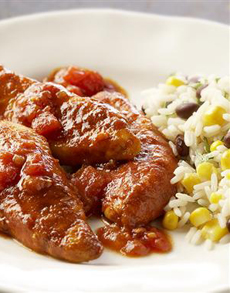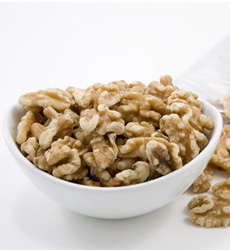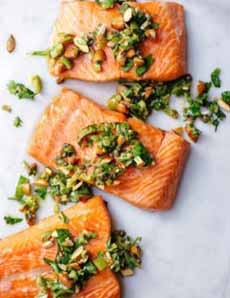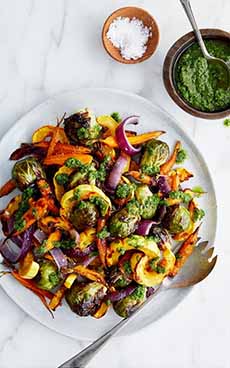|
January 18th is National Peking Duck Day. We’ll be running out to our favorite Chinese restaurant for the real deal, which we’ve been enjoying since childhood. It’s our favorite Chinese dish.
WHAT IS PEKING DUCK?
Only white-feathered ducks are used in the preparation, what we call Pekin ducks (not to be confused with Peking, the name of the dish; the Pekin breed was introduced to the U.S. from China in 1873).
The ducks live free-range for 45 days, and then are force-fed for 15 to 20 days. Once harvested with the head remaining on, the duck is plucked and washed.
Air is pumped into the raw duck to separate the skin from the fat. This enables the extensive amount of fat found between the meat and the skin to drain out during cooking.
The duck is then hung up to dry in the open air overnight before being glazed with sweet syrup and spices and roasted in an oven [source].
The layer of air enables the skin to become very crisp while the meat inside remains succulent.
Then, a skilled maitre d’ slices the duck in front of you, expertly converting the whole duck into thin slices of meat and slices of crisp skin.
To assemble your food, wrap-style, you take a crêpe (some restaurants serve thicker pancake-style wrappers), add a slice of duck meat and skin, garnish with hoisin sauce, julienned cucumbers and scallions (green onions), roll and eat. It’s heavenly.
The duck carcass goes back to the kitchen, where it is presumably used to make stock. We’ve dined with more than one friend who asked for the carcass “to go,” and did the same at home.
By the way, Peking Duck, the roasted duck dish and Pekin duck, a breed of white duck that inspired the creation Donald Duck, are not the same. While Peking Duck is typically made with a Pekin duck, learn the difference between Peking Duck and Pekin duck.
HOW TO APPROXIMATE PEKING DUCK AT HOME
Here’s how to enjoy almost-there Peking Duck tonight.
Ingredients
Pick up a cooked roast duck. We like Maple Leaf Farms Duck, which is fully cooked and frozen, ready to heat-and-eat. The skin won’t be thick and crisp like a specially prepared Peking Duck, but it’s close enough for your quick homemade dinner.
Get the crêpes. If your store has flat (as opposed to filled) crêpes ready made (often in the caviar case), pick them up. Otherwise, pick up some 8-inch tortillas.
Actually, tortillas are too thick and “bready” for us. When we can’t find crêpes and don’t want to make them, we’ll substitute lettuce leaves, in the manner of Korean and Vietnamese meat wraps.
Rice paper wraps, used for summer rolls, are another option.
Get the cucumbers and scallions.
Get a jar of hoisin sauce. You’ll find it in the Asian foods aisle.
You’re almost ready to celebrate Peking Duck Day.
Preparation
1. HEAT the duck. While the duck is heating, julienne the cucumbers and scallions into sticks (see photo) and plate them. They can be in individual dishes or on the same plate. Put the hoisin sauce in a bowl.
2. REMOVE the duck from the oven and slice. Don’t worry if it doesn’t look pretty; it’s ultimately going into a wrap.
3. HEAT the crêpes/tortillas for 10-20 seconds in the microwave.
4. SIT down and enjoy the fruits of your labor. Take a crêpe/tortilla, add some duck, cucumber, scallion and hoisin sauce; wrap and eat.
The beverage choice is yours. We enjoy a cup of good black tea (no sugar needed, and definitely no milk) or a beer.
A HOISIN SAUCE PRIMER
Hoisin sauce (HOY-sin) is a thick, sweet-and-pungent condiment that’s used much the way we use barbecue sauce (but the taste is completely different). It can be used to coat meat and poultry prior to cooking, it can be stirred into dishes and, as in the case of Peking Duck, it can be used as the principal condiment—a very elegant “ketchup.”
The flavor of hoisin sauce has always seemed pruny-plummy to us (in the sense of a sweet fruitiness of roasted plums). In fact, recipes for a hoisin sauce substitute can include prunes. However…
There’s no fruit in traditional hoisin sauce unless you count a touch of chiles, which are, by botanical definition, fruit.
The base of hoisin sauce is soybean paste, which is then flavored with garlic, vinegar and sometimes other spices. The resulting sweet-and-spicy paste is extremely flavorful and may overwhelm people who try it the first time. But keep trying; you’ll learn to love it.
Some restaurants serve a sweet bean sauce instead of hoisin sauce.
PEKING DUCK HISTORY
The recipe for Peking Duck dates back to the Ming Dynasty, the ruling dynasty of China from 1368 to 1644.
Top cooks from all over China travelled to the capital, Beijing, to cook for the Emperor. The best cooks might even advance to the rank of a minister [source].
In the royal kitchens, dishes of exceptional quality such as Peking Duck were created.
Although Peking duck is named after Beijing (Peking is an older spelling), it originated in the earlier Chinese capital of Nanjing.
In the Ming dynasty, the imperial court moved to Beijing, bringing the emperor’s recipes along with it.
By then, Peking duck was an established staple of imperial menus. In the subsequent Qing dynasty (1644 to 1912), Peking Duck spread to the nobility. The dish was much praised in the writings of scholars and poets [source].
With the fall of the Qing Dynasty (also spelled Ching and Ch’ing) in 1911, court chefs who left the Forbidden City set up restaurants around Beijing, bringing Peking Duck and other delicious dishes to their customers.
|
|
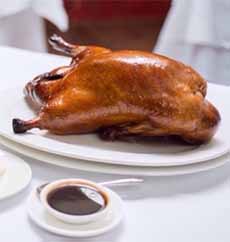
[1] Beautifully roasted and ready to slice (photo © Red Stix [alas, permanently closed]).

[2] Peking Duck starts with a beautifully roasted and glazed Pekin-species duck (photo © Jing Fong | NYC).
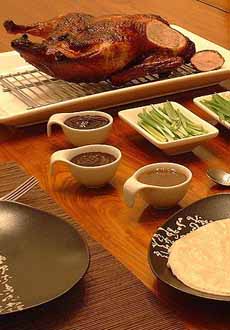
[3] Peking Duck, waiting for the maitre d’ to slice and plate the duck meat and duck skin. The carved meat is presented with shredded scallions, hoisin sauce, and crêpes to hold all three (photo by Fotoos Van Robin | Wikipedia).

[4] The most elegant plating displays the meat in the center, surrounded by piece of the crisp skin (photo © T. Tseng CC-BY-2.0-License).

[5] Place the duck and scallions on the crêpe, add hoisin sauce and roll up (photo © Polina Tankilevitch | Pexels).

[6] Rolled and ready to eat (photo © Marcin Krakowiak CC-BY-NC-ND-2.0-License).
|
